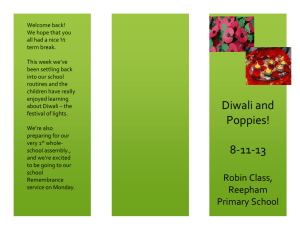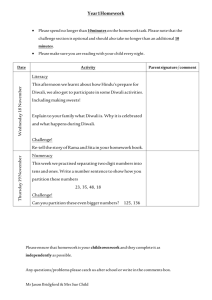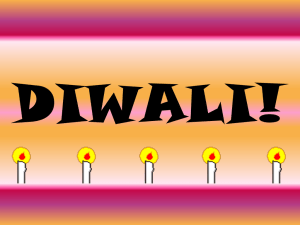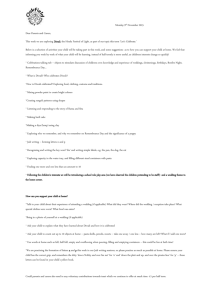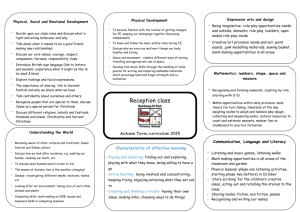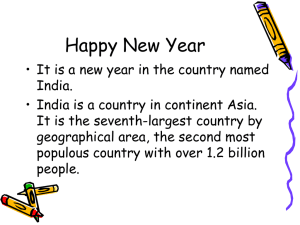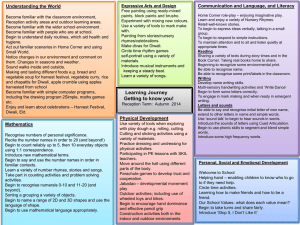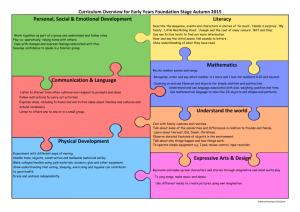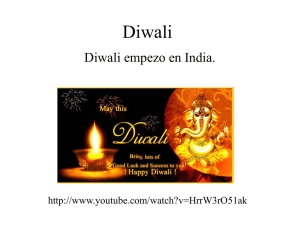A.What is Diwali?
advertisement
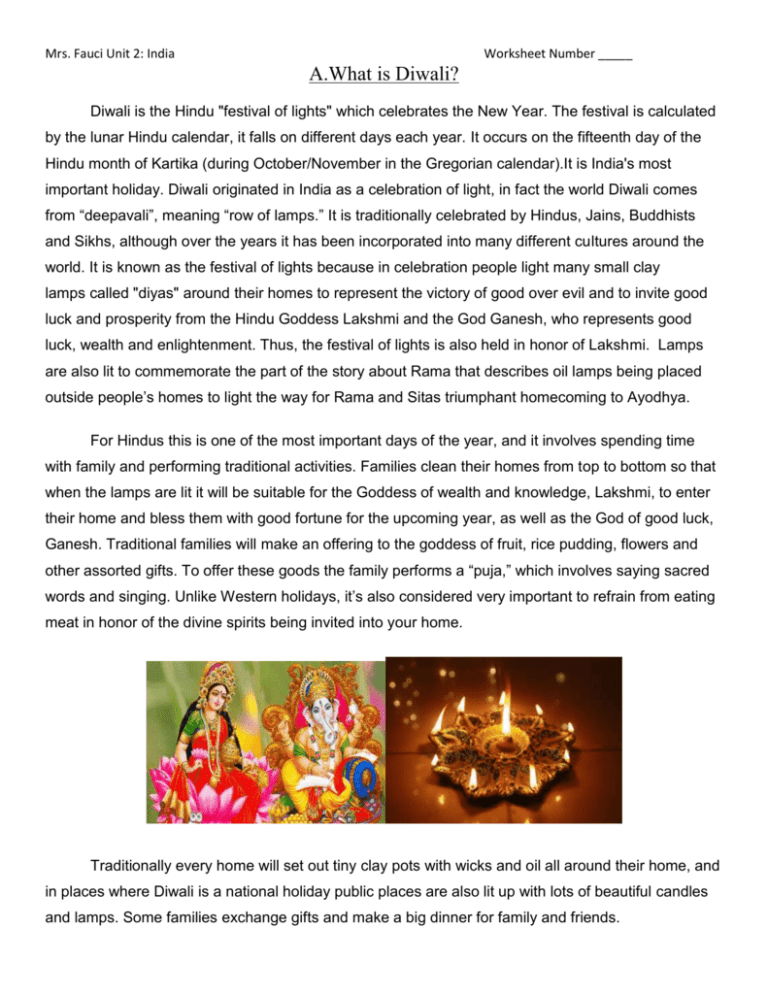
Mrs. Fauci Unit 2: India Worksheet Number _____ A.What is Diwali? Diwali is the Hindu "festival of lights" which celebrates the New Year. The festival is calculated by the lunar Hindu calendar, it falls on different days each year. It occurs on the fifteenth day of the Hindu month of Kartika (during October/November in the Gregorian calendar).It is India's most important holiday. Diwali originated in India as a celebration of light, in fact the world Diwali comes from “deepavali”, meaning “row of lamps.” It is traditionally celebrated by Hindus, Jains, Buddhists and Sikhs, although over the years it has been incorporated into many different cultures around the world. It is known as the festival of lights because in celebration people light many small clay lamps called "diyas" around their homes to represent the victory of good over evil and to invite good luck and prosperity from the Hindu Goddess Lakshmi and the God Ganesh, who represents good luck, wealth and enlightenment. Thus, the festival of lights is also held in honor of Lakshmi. Lamps are also lit to commemorate the part of the story about Rama that describes oil lamps being placed outside people’s homes to light the way for Rama and Sitas triumphant homecoming to Ayodhya. For Hindus this is one of the most important days of the year, and it involves spending time with family and performing traditional activities. Families clean their homes from top to bottom so that when the lamps are lit it will be suitable for the Goddess of wealth and knowledge, Lakshmi, to enter their home and bless them with good fortune for the upcoming year, as well as the God of good luck, Ganesh. Traditional families will make an offering to the goddess of fruit, rice pudding, flowers and other assorted gifts. To offer these goods the family performs a “puja,” which involves saying sacred words and singing. Unlike Western holidays, it’s also considered very important to refrain from eating meat in honor of the divine spirits being invited into your home. Traditionally every home will set out tiny clay pots with wicks and oil all around their home, and in places where Diwali is a national holiday public places are also lit up with lots of beautiful candles and lamps. Some families exchange gifts and make a big dinner for family and friends. Mrs. Fauci Unit 2: India Worksheet Number _____ B. The Meaning of Diwali It is since ancient times that Diwali has been celebrated. It is not easy to say now what really was the reason behind its origin. Different people believe different events to be the cause behind this festival. The most well-known story behind Diwali is in the Ramayana, the great Hindu epic. According to Ramayana, Rama, the prince of Ayodhya was ordered by his father, King Dasharatha, to go away from his country and come back after living in the forest for fourteen years. So Rama went on exile (was banished) with his devoted wife Sita and faithful brother, Lakshmana. When Ravana, the demon king of Lanka kidnaped Sita and took her away to his island kingdom of Lanka, Rama fought against and killed Ravana. He rescued Sita and Rama and Sita returned to Ayodhya after fourteen years of exile. The people of Ayodhya were very happy to hear of their beloved prince's homecoming. To celebrate Rama's return to Ayodhya, they lit up their houses with earthen (clay) lamps (diyas), burst firecrackers and decorated the entire city in the grandest manner. This is believed to have started the tradition of Diwali. Year after year this homecoming of Lord Rama is commemorated on Diwali with lights, fireworks, bursting of firecrackers and celebration. The festival gets its name Deepawali, or Diwali, from the rows (avali) of lamps (deepa) that the people of Ayodhya lit to welcome their King. Diwali also originated as a harvest festival that marked the last harvest of the year before winter. India was an agricultural society where people would seek the divine blessing of Lakshmi, the goddess of wealth, as they closed their accounting books and prayed for success at the outset of a new financial year. Today, this practice extends to businesses all over the Indian subcontinent, which mark the day after Diwali as the first day of the new financial year. The Festival of Lights, as with most ancient legends, helps us to know the truth of victory of good over evil, but more specifically for Hindus at this time, it means to understand the meanings behind each of the five days of Diwali. Mrs. Fauci Unit 2: India Worksheet Number _____ C. Five Days of Diwali Diwali is the festival of lights and is celebrated with great enthusiasm by all Indians all over the world. The uniqueness of this festival is its harmony of five varied philosophies, with each day to a special thought or ideal. People celebrate each of its five days of festivities with true understanding, it will uplift and enrich the lives. The first day of Diwali: Dhanteras The first day of Diwali is called Dhanvantari Triodasi or Dhanwantari Triodasi also called Dhan Theras. It is in fact the thirteenth lunar day of Krishna Paksh, the two weeks before the month of Kartik. On this day, Lord Dhanwantari came out of the ocean with Ayurvedic for mankind. This day marks the beginning of Diwali celebrations. On this day at sunset, Hindus should bathe and offer a lighted deeya and jewelry with Prasad (sweets offered at worship time) to Yama Raj, the Lord of Death and pray for protection from early death. This offering should be made near a Tulsi tree, the Holy Basil or any other sacred tree that one might have in their yard. Sheera is also eaten - a warm fudge-like sweet made with raisins, nuts, semolina, saffron and cardamom and - is eaten with a spicy black-eye bean curry. The second day of Diwali: Choti Diwali The second day of Diwali is called Narak Chaturdasi. On this day Lord Krishna destroyed the demon Narakasur, who imprisoned many sons and daughters of the Gods, and made the world free from fear. On this day, one should massage the body with oil to relieve it of tiredness, bathe and rest so that Diwali can be celebrated with strength and devotion. This is a day of fasting for many Hindus, and they do not break their fast until sunset with lapsee, a warm sweet porridge of cracked wheat, clarified butter and sugar. On this night, Yama Deeya should not be lit. The Shastras (Laws of Dharma) declares that Yama Deeya should be offered on Triodasi night with Prasad. The third day of Diwali: Lakshmi Puja on Diwali Lakshmi Puja is the day when worship unto Mother Lakshmi is performed. This is known as Diwali Day. This day is spent eating with the family and visiting all the friends and neighbors. Many different types of vegetable curries are eaten. They like to include as many vegetables as possible as this Mrs. Fauci Unit 2: India Worksheet Number _____ signifies wealth and bounty lasting for the whole year. A huge assortment of sweets is always available. Hindus cleanse themselves and join with their families and their Pandit (priest) and they worship the divine Goddess Lakshmi to achieve the blessings of wealth and prosperity, the triumph of good over evil and light over darkness. In the evening, many people hold a small prayer (puja) in their homes. They honor Ganesh the god of wisdom and good luck, the one who removes all obstacles from life. They worship Lakshmi, the goddess of wealth and good fortune. Lights are left burning all night, so that Lakshmi may feel welcomed and enter. The fourth day of Diwali: Padwa & Govardhan Puja The fourth day is Padwa & Govardhan Puja. Many thousands of years ago, Lord Krishna caused the people of Vraja to perform Govardhan Pooja (prayers). From then on, every year Hindus worship Govardhan to honor that first Pooja done by the people of Vraja. The fifth day of Diwali: Bhai Duj The fifth day of Diwali is called Bhai teeka. This is the day after Goverdhan Pooja is performed and normally two days after Diwali day. It is a day dedicated to sisters. Many years ago, in the Vedic era, Yama (Yamraj, the Lord of death) visited his sister Yamuna on this day. He gave his sister a Vardhan (a boon) that whosoever visits her on this day shall be liberated from all sins. They will achieve Moksha or Hindu heaven. From then on, brothers visit their sisters on this day to see how they’re doing. One of the last things done on Diwali is to drive out Alaksmi, or the goddess of bad luck, poverty and misfortune. Traditionally the oldest woman in the family will sweep the house to rid it of bad luck. This day marks the end of the five days of Diwali celebrations. Mrs. Fauci Unit 2: India Worksheet Number _____ D. How is Diwali Celebrated? 1. It is customary to go shopping. Many buy utensils and ornaments on the first day of Diwali. 2. You must also clean your house and business premises thoroughly before the first Diwali day. Do the laundry, clean all the rooms and sort out your papers in both your home and business. It's like a spring cleaning of sorts, a "cleansing" ritual to rid yourself of any unnecessary elements in your environment. Draw small footprints using rice flour and vermillion powder over your house (rangoli); this is a way of indicating that you're awaiting the arrival of the Goddess. 3. Make the entrance way to your home or business colorful using the traditional motifs of Rangoli designs. These include bells, flower garlands, wall hangings, mirrors, LED lights, etc. This is a joyful way to welcome the Goddess of Wealth and Prosperity. 4. Burn lamps every night during the festival. In the evening, light small oil lamps (called "diyas") and place them around the home. Turn all the lights on and light some candles. The lamps symbolize knowledge or one's inner light, which brings about inner peace and fights off any traces of darkness and ignorance. 5. Light some firecrackers and fireworks. These are a common part of Diwali, used to symbolize warding off evil from your surroundings. They are usually set off in greatest numbers on the actual day of Diwali. 6. Bake sweets and snacks. These are traditional offerings for Diwali and are given as gifts. 7. Wear new clothes and jewels on the second and third days. Women wear a sari, the traditional Indian dress for women. Men normally wear kurthas, the national clothes for Indian men. 8. There is also a tradition of gambling on Diwali because it has legend behind it. It is believed that, Goddess Parvati played dice with her husband Lord Shiva, and she decreed that whosoever gambled on Diwali night would prosper throughout the ensuing year. Diwali is associated with wealth and prosperity in many ways. 9. Go vegetarian. For many Indians, Diwali is a meatless holiday. There aren't any set dishes, so the choices can be varied but it is important to include sweets, as Diwali is about sweets. Mrs. Fauci Unit 2: India Worksheet Number _____ E. Rangoli Rangoli' is a Sanskrit word which means a creative expression of art through the use of color. The word rangoli may also have come from "rang" (color) + "aavalli" (row), which means row of colors, or from rang+avalli, which means creepers of colors. People decorate their homes and temples by drawing patterns on the ground outside. They draw these designs with a mixture of rice flour and water. Colored powder, such as sand, is sometimes used. Designed with a beautiful combination of various colors, the Rangoli images create an enchanting piece of art. Basically a floor painting, a rangoli image stands for a sign of welcome. The main purpose of making rangolis in Diwali is to welcome Goddess Laxmi, the Goddess of wealth, to individual homes apart from warding off the evil eye. The art of rangoli is known by different names in different regions such as "Rangoli" in Maharashtra, Alpana (in Bengal), and Kolam (in South India). Although Rangoli has its origins in Maharashtra, today it is practiced everywhere. One of the most popular arts among Indian women, rangoli is an age old custom of India, and practiced all over the country. The Rangoli designs are passed down through generations, with some of them being hundreds of years old. Though the designs vary in different sections of India, the basic approach is common. The designs are geometric and proportioned. It has been a tradition in culturally rich India to draw Rangoli on the festivals and other occasions as it is considered a holy ritual. There is a unique relationship between the festival of Diwali and rangoli. Diwali is a major festival of India and drawing rangoli on Diwali is a part of Diwali celebrations. The patterns are made with fingers using rice powder, crushed lime stone, or colored chalk. They may be topped with grains, thumps, beads, or flowers. Since the entire objective of making rangoli in Diwali is to welcome Goddess Laxmi, small footprints coming into the home, representing the footprints of the Goddess, are also made. Rangolis can be of any size, from the size of a doormat, to the size of an entire room. Though making of a Rangoli is highly dependent on the preferences and skills of the maker, lines are always drawn on one finger movement (rangolis are always drawn with fingers) and frequently, the mapping of the rangoli is done with the help of dots, which are joined to form a pattern, and then the pattern is filled with colors. Mrs. Fauci Unit 2: India Worksheet Number _____ One important point is that the entire pattern must be an unbroken line, with no gaps to be left anywhere, for evil spirits are believed to enter through such gaps, if they find one. In an expert hand, the images created are elaborate and look as if they are painted. In India, this art is temporary. Each rangoli design generally stays for only a day or two as it is often redone as a part of the daily routine. Certain designs are created on special occasions such as weddings and religious festivals like Diwali. Mrs. Fauci Unit 2: India Name:______________________________________ Worksheet Number _____ Date:_____________________ Directions: You have been assigned a team number and a group letter. Each team member will become the expert on their letter(s) and answer the questions that correspond to their letter(s). You will then teach your answers to your team. Each group must also answer the group question (part F). A. What is Diwali? 1. Diwali is the Hindu __________________________________ which celebrates the New Year. It is India's most important holiday. 2. The name originally comes from the Sanskrit word dipvali, meaning a _________________________________________. 3. Why is Diwali known as the festival of lights? ______________________________________________________________________________ 4. The festival of lights is held in honor of Lakshmi the Hindu goddess of _______________________ and ________________________. B. The Meaning of Diwali 5. Diwali celebrates the return of ____________________________and ________________________ after fourteen years of exile, in the story from the Ramayana. 6. The festival gets its name Deepawali, or Diwali, from the _____________________ (avali) of ____________________ (deepa) that the people of Ayodhya lit to welcome their King. 7. Diwali also originated as a harvest festival that marked the last harvest of the year before ___________________________. 8. India was an agricultural society where people would seek the divine blessing of _________________________, the goddess of wealth, as they closed their accounting books and prayed for success at the outset of a new financial year. Mrs. Fauci Unit 2: India Worksheet Number _____ C. The Five Days of Diwali 9. Day 1- Dhanteras: On this day at sunset, Hindus should __________________ and offer a lighted deeya and______________________ with Prasad (sweets offered at worship time) to Yama Raj, the Lord of Death and ________________________for protection from early death. 10. Day 2- Choti Diwali: On this day, one should massage the body with oil to relieve it of tiredness, ________________________and _______________________ so that Diwali can be celebrated with strength and devotion. This is a day of ______________________ for many Hindus, and they do not break their fast until sunset with lapsee. 11. Day 3- Lakshmi Puja on Diwali: This day is spent _____________________ with the family and visiting all the friends and neighbors. Many different types of _________________________ curries are eaten. In the evening, many people hold a small________________________ (puja) in their homes for Lakshmi and Ganesh. 12. Day 4- Padwa & Govardhan Puja: Many thousands of years ago, Lord Krishna caused the people of Vraja to perform Govardhan Pooja (prayers). From then on, every year Hindus ___________________ Govardhan to honor that first Pooja done by the people of Vraja. 13. Day 5- Bhai Duj: It is a day dedicated to ___________________________. Brothers visit their sisters on this day to see how they’re doing. One of the last things done on Diwali is to drive out Alaksmi, or the goddess of bad luck, poverty and misfortune. Traditionally the oldest woman in the family will __________________ the house to rid it of bad luck. D. How is Diwali celebrated? 14. List one way that Diwali is celebrated. Which holiday that you celebrate is this similar to? How? _________________________________________________________________________________ _________________________________________________________________________________ 15. List one other way that Diwali is celebrated. Which holiday that you celebrate is this similar to? How? _________________________________________________________________________________ _________________________________________________________________________________ _________________________________________________________________________________ Mrs. Fauci Unit 2: India Worksheet Number _____ E. Rangoli 16. __________________________________is a Sanskrit word which means a creative expression of art through the use of color. 17. The main purpose of making rangolis in Diwali is to welcome _____________________________, the Goddess of wealth, to individual homes apart from warding off the evil eye. 18. The Rangoli designs are passed down through _____________________________, with some of them being hundreds of years old. F. Group Question (to be answered as a group) 19. Why is it important that we learn how and why Diwali is celebrated? _________________________________________________________________________________ _________________________________________________________________________________ _________________________________________________________________________________
